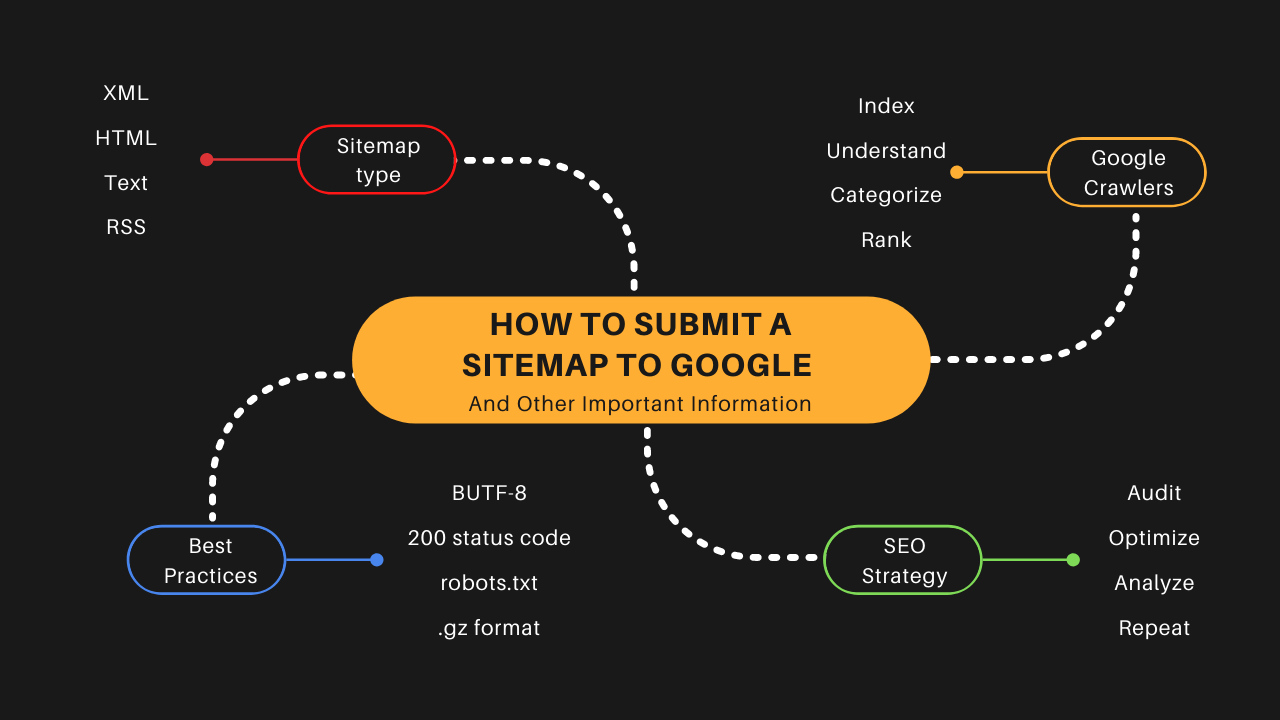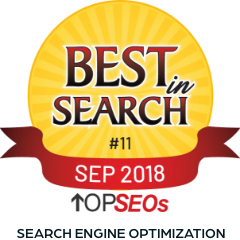How to Submit a Sitemap to Google in 6 Steps
- Create a Google account if you don’t already have one
- Sign in to your Google Search Console account
- Select your website
- Select “Sitemaps”
- Delete any outdated or invalid sitemaps
- Add your updated sitemap and click SUBMIT
Yup, that’s it. Real easy.
But BEFORE you go hitting that SUBMIT button, there are some important things you should know about sitemaps that will help you ensnare those Google crawlers in your web(site) and get more organic traffic.
What is a sitemap?
So, you’ve already learned how to submit a sitemap to Google. Perhaps you should know what a sitemap actually is to understand how important they are to your technical SEO strategy.
A sitemap is simply a technical directory of all the important pages on your website that indicates to Google crawlers the relevancy and usefulness of certain portions of your business site.
Google’s bots use these directories to index your site. Search engine indexing essentially means an algorithm is collecting, analyzing, categorizing, and storing data from various websites to increase the speed and accuracy of information retrieval.
In other words, when you increase the crawlability of your website, you increase your organic traffic opportunities as well.
Google algorithms automatically crawl the web to discover relevant links; however, submitting your sitemap directly through Google Search Console greatly increases your website’s visibility to bots, allowing them to index, understand, and rank your website quicker.
Types of Sitemaps
While there are several sitemap formats, the two most common are XML and HTML.
Let’s compare:
What is an XML sitemap?
An XML sitemap looks something like this:

This is just a very short snippet of what your XML sitemap would look like. To humans outside of programming, this might as well be a bunch of ones and zeros, but this is a Google crawl bot’s favorite reading material – they tend to be picky though, so be sure to read through to our “Sitemap Best Practices” section to find out the minimum standards your XML sitemap must meet.
If you haven’t already guessed, XML sitemaps are meant for search bots only. They also include meta-attributes, such as <lastmod> (as seen above) and <changefreq> to signal to bots how your URL changes.
Site updates tell Google’s search algorithms that your website is likely relevant and useful, which increases your ranking over time. Some dynamic content to include in your sitemap are customer testimonials and blog posts.
Overall, your XML sitemap should only include the most important web pages on your site and exclude more static pages, such as contact forms, and ones you don’t want to be crawled, such as seasonal pages.
What is an HTML sitemap?
An HTML sitemap is simply a list of URLs found on a dedicated webpage. The link to a sitemap is generally found at the very bottom of the main website pages, such as on our SeoTuners website:
Here’s just a snippet of our HTML sitemap (as HTML sitemaps can be quite long):
One thing you should notice is that we’ve grouped our most important content by topic. Our main categories are “pages” and “posts”. Under our “posts” category, there are subcategories, which include Advertising, Content, Ecommerce, Local, Marketing, Mobile, Penalty Updates, PPC [pay per click], SEO [search engine optimization], Social, and Web Design Posts.
You can visit our sitemap here to get a better feel for what to include on your HTML sitemap and how to organize it.
HTML sitemaps are used by Google bots but are also a convenient way for users to navigate your site by having all your most relevant pages on a single webpage.
Sitemap Best Practices
1) Make sure your sitemap meets these minimum standards:
- BUTF-8 encoded
- Compressed into .gz format
- Is referenced in the robots.txt
- Contains only canonical URLs with a 200 status code
- Does not exceed 50,000 URLs or 50MB uncompressed (whichever comes first)
2) Include only the most important pages of your website:
How do you decide which pages are important?
- Prioritize dynamic web pages over static pages. Dynamic pages are web pages such as blog posts, customer testimonials, and calendars. Static pages might include dedicated contact pages that don’t need to be a priority.
- Categorize your content. Group like with like – and if a page is unrelated to your primary purpose, ditch it.
- Exclude “noindex” URLs. These are pages that you wouldn’t want to be crawled or indexed to ensure they don’t show up on the results pages. Such pages might include internal search results, admin or login pages, thank you pages, custom post types, and author archives. These can cut into your crawl budget and divert bots from your site entirely.
3) Use multiple sitemaps as needed.
The sitemap file size limit is 50,000 URLs or 50MB, which might sound like a lot, but can actually be exceeded rather quickly for larger sites.
For example, e-commerce sites generally have many individual product pages along with their primary web pages. Ecommerce businesses can create separate sitemaps for their product pages, categories pages, and main website.
These individual sitemaps can then be organized into a sitemap index file that allows you to submit all your files at once. These sitemap index files direct Google crawlers to each section of your website through various sitemaps.
4) Create sitemaps for videos and images.
Google provides extensions that allow you to create a separate sitemap for videos and images embedded in your website. You can even include these video and image maps within existing sitemaps. They provide additional scaffolding for Google bots to crawl, providing more information to help bots better understand and rank your files for relevant search terms.
5) Fix any sitemap errors you find ASAP. (That’s it. Get them fixed or see your rankings drop.)
6) Submit your sitemap through Google Search Console.
As we previously stated, you don’t necessarily need to submit your sitemap directly to Google, but it is advantageous to do so. Submitting your sitemap to Google allows their bots to be more efficient in indexing, parsing, and understanding the relevance of your page for ranking.
7) Conduct a website audit to ensure it’s up to spec.
You should really do this before you even submit your sitemap to Google to make sure there are no broken links, missing images, faulty meta tags, etc. You should check your website’s site speed, on-page SEO, off-page SEO, and meta descriptions. You can check out our SEO audit checklist for more details or use our free SEO audit tool to see if your landing page or blog posts are optimized for keywords.
8) Hire an expert.
The above steps might seem easy enough, but as you probably know by now, there’s much more to creating a sitemap than just logging into Google Search Console and hitting the SUBMIT button.
Don’t let your rankings suffer due to technicalities. Hire an SEO professional like SeoTuners. We offer innovative internet marketing solutions that will increase your online visibility and help you outrank your competitors. You can call for a free SEO consultation at (877) 736-1112 or drop us a line via our contact form.










